We’ve decided it’s time to stop putting off adding goats to the farm. I was surprised on Christmas morning, with an envelope from Mr. Curbstone that contained copies of the pedigrees, and due dates, of two Nigerian Dwarf Dairy Goat doe kids. Unbeknownst to me, he’d reserved them with the breeder a few weeks before the holidays. The doelings, from two different mothers, are due to be born late-February, and early March at Castle Rock Farm. So in case you haven’t yet heard…we’re getting goats this spring!
Why Goats?
A few years ago, we used to joke that having goats here would be far more efficient than either one of us at beating back 25 years of rampant weedy growth on the property.
Remember this mess? Although I have no doubt the goats will enjoy our ever-multiplying blackberry vines, brush clearing is not really why we’ve decided to bring goats to the farm.
It’s the milk of course…and the cheese…not to mention the sheer joy of having goats bouncing around the farm!
We’ve both been coveting the goats of others for some time. We have even, not actually owning goats, been spied covertly visiting dairy goat shows. A few people may have thought we were crazy, but it’s actually a great place to learn more about goats, goat breeds, conformation, dairy character, and judging, and also a good place to meet with, and talk to, goat breeders too.
As fun as we knew adding goats to the farm would be, we clearly weren’t rushing into it. I have some previous experience with goats, and I can say that although they’re not difficult to keep per se, they do require significantly more knowledge, TIME, resources, and commitment, than say our chickens, or turkeys. In fact, the goats will demand more attention than our dogs, and our dogs get a LOT of attention…
…although I admit they’re rather spoiled.
Goatland Security
Like our poultry though, our greatest initial concern on the goat-front is ‘goatland security’. No joke. We live in the middle of the woods, with a constant stream of predators, of various shapes and sizes, traipsing through the farm. As browsers, goats love woodland areas, but so do coyotes, bobcats, and mountain lions.
If you follow this blog, you know we’ve had various encounters with bobcats, and coyotes. Although we personally haven’t sighted a lion since moving here, neighbors have assured us they’ve been seen on the property in past years, and reports of livestock losses to lions in this area do happen [1,2,3,4]. It’s a very real, and serious threat, and sadly, all too often, the reason for such losses is due to a lack of adequate, secure enclosures. That said though, domestic dogs that are allowed to run loose are probably an even more likely threat here than the lions [5].
At first we wondered if we could even have goats here, but we’ve spoken to others who do successfully keep goats in this area, and then did some homework, studying enclosure recommendations through the Mountain Lion Foundation.
We’re also seriously looking into bringing in a livestock guardian dog, but even livestock guardians are no guarantee against predators, especially big cats, and certainly no substitute for secure enclosures, and it takes time to raise the puppy to become an effective guardian.
We accept that by bringing goats here, we’re inviting apex predators to the farm. As such, it is our responsibility to keep our goats safe, and by keeping the goats safe, and not allowing them to become easy fodder for predators, we are also protecting the wildlife that lives here. If we lose a goat to a predator, it’s our fault, not the predator’s fault. That said, we have no intention of feeding our predator population.
The two main steps we need to take to secure our goats are to construct both a predator-proof barn, and a secure daytime enclosure for when we can’t be outside with them. I’ll get more into the enclosure outside the barn in a future post.
This week though, we’re focusing on the barn itself. Well, “barn” might be a little ambitious. These are dwarf goats, so it’s probably more accurate to call it a shed, but I seem to find myself calling it a barn anyway, as functionally that’s how it will be used. Albeit a very small barn, for very small goats.
Barn Design
When designing our mini-barn, we had a few factors to consider.
1) Terrain
We can’t change that there’s not much flat land here, so even though we could design an elaborate barn, ultimately, we have to build what will fit.
2) Goats HATE rain
In a wet year, like last year, it can rain from October to June. Being on the coastal side of the mountain, some years that amounts to a tremendous amount of rainfall! Did I mention that goats hate the rain? A dry goat, is a happy goat. First and foremost, the barn MUST be dry.
3) Milking in the rain, is NOT an option. Even if the goats didn’t mind the rain, I certainly do!
Both the goats, and this farm wife, will be much MUCH happier if twice-daily milking is conducted in a nice dry cozy corner of the barn, out of drafts, without sitting in puddles, or having cold water running down the back of our necks. Not to mention, milking in the rain simply isn’t sanitary.
4) Good ventilation is critical to healthy goats
Goats, like most farm-stock, are very sensitive to poor air quality. The barn area needs to be dry, free of drafts, but more importantly, well ventilated. Dust, mold spores, ammonia odors, and excessive humidity, all can impact a goat’s (and a farmer’s) respiratory health, negatively. Although the barn should be dry, it shouldn’t be airtight by any means. I might be happier in an R-40 insulated structure, with triple glazed windows, but the goats are not.
5) Future Goats.
To make milk, first, you make more goats.
To keep goats in milk, they need to reproduce, so the barn needs to be able to accommodate the occasional baby goat, or three (or more, as Nigerian Dwarfs are prone to multiples).
6) For a small herd one stall is mostly, but not always, enough (see number 5).
Goats enjoy the company of other goats, and generally we expect the goats will all be in the same stall at night together. As much as we hope to the contrary though, occasionally a goat may become ill, or injured, or a doe may be too pushy around another doe, or kid. As such, having an area to separate a goat to temporarily, if necessary, can be helpful.
The Plan*
Overall, our primary aim is to give the goats as much space as possible, including enough covered areas for when our weather is less than ideal. The best approach for this small barn seemed to be to keep things as flexible as possible. An adaptive shed of sorts, that can be changed up as the goat’s needs change.
Bearing all these things in mind, we scribbled numerous ideas on pieces of paper, napkins, business cards etc., and finally narrowed it down to a simple, but what we hope will prove to be a functional, mini-barn for our impending arrivals.

The current floor plan has a cozy area for milking, and a section of the loafing stall that can be divided to create a temporary second pen (click image to enlarge)
Before shed building could commence though, we first had to prepare the foundation. That started with some brush clearing, which would have been easier with goats, than without, but somehow we managed.
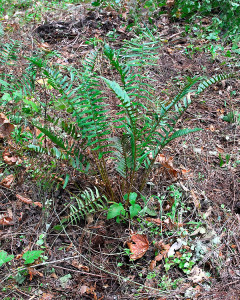
The weeds were cleared, but plants like this Western Sword Fern were relocated to outside the enclosure area
For the foundation itself, we considered dirt floors, and some goat owners prefer them, but with as much as it rains in a wet year here, with our slopes, the shed would likely fill with water.
Wood floors can work, but they tend to hold odors, and moisture, and with the change in grade down our slope, we didn’t feel that was good for a shed in this location either, as we’d still have to build up a foundation for a level floor. This seemed to rule out most kit sheds, and even some build-on-site custom shed services, as most rely on the use of wood floors, on perfectly level plots.
Ultimately we settled on a concrete floor. It’s easy to clean, and with the addition of a waterproofing agent in the concrete mix, the floor will stay dry.
Concrete can be cold, however, but additional shavings or bedding straw, and potentially even the use of stall mats under the bedding, all can help to mitigate that.
We’ll also be constructing sleeping benches, so the goats will most likely sleep on those, rather than directly on the floor.
As mentioned in point 2 above, the “goats hate rain” part, we’ve chosen to design the barn such that we can gate off the milking area during the day when not in use, which will leave the alley to the stall open.

The stall gate does double duty. It closes off the loafing stall to confine the goats, or closes off the milking area when providing free in-and-out access for the goats to the yard
This will allow the goats to come and go outside at will during the day, from the goat yard, up to the deck, and in to the stall. During periods of extended unpredictable weather, the idea is that the goats can be outside if they chose, with free access the stall when it rains…but gating off the stanchion area will help keep the milking area a little cleaner.
If the goats are spending an extended period indoors, the barn’s dutch door should help to improve ventilation throughout the building during the day. There will also be two gable end wall vents, in addition to three small windows along the walls that will be INSIDE the fenced, covered enclosure.
In case the kidding stall needs to be used for a pregnant doe, or an ill goat, our plan is to construct a partition gate through part of the loafing area.
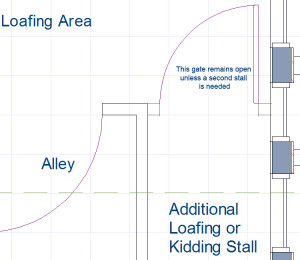
This secondary stall gate can be left open most of the time, but will serve to partition off a small pen if needed
The gate will be bolted open against the wall when not in use, but can be closed off to create an extra ‘stall’ when needed. If that area isn’t in use though, we’ll leave it open to give the goats the use of the extra space.
So that’s the rough plan, of course, plans are always subject to change*. Although we have most of the area cleared, and the foundation is complete, we still have a lot to get done before the goats arrive!
The forms came off the foundation this afternoon, so this weekend, the concrete will be cured enough to get the walls and roof framed, and if all goes well, we may even get the siding installed. Things might be a little quiet on the blog during the rest of construction, but we promise, more soon!
—————————————
[1] Mountain Lion Kills 4 Baby Goats Near Swanton in ‘Wholesale Slaughter’, Owner Says. Santa Cruz Sentinel. February 27, 2010
[2] Mountain Lion Comes Back for Seconds, Kills Baby Goat. Santa Cruz Sentinel. January 15, 2010.
[3] Livestock Kills Prompt Fears of Big Cat on the Prowl in Santa Cruz County. Santa Cruz Sentinel. January 3, 2010.
[4] Mountain Lion Sightings Not Uncommon. Scotts Valley Press Banner. January 28, 2010.
[5] Dogs suspected in Pygmy Goat Deaths in Ben Lomond. Santa Cruz Sentinel. February 3, 2011

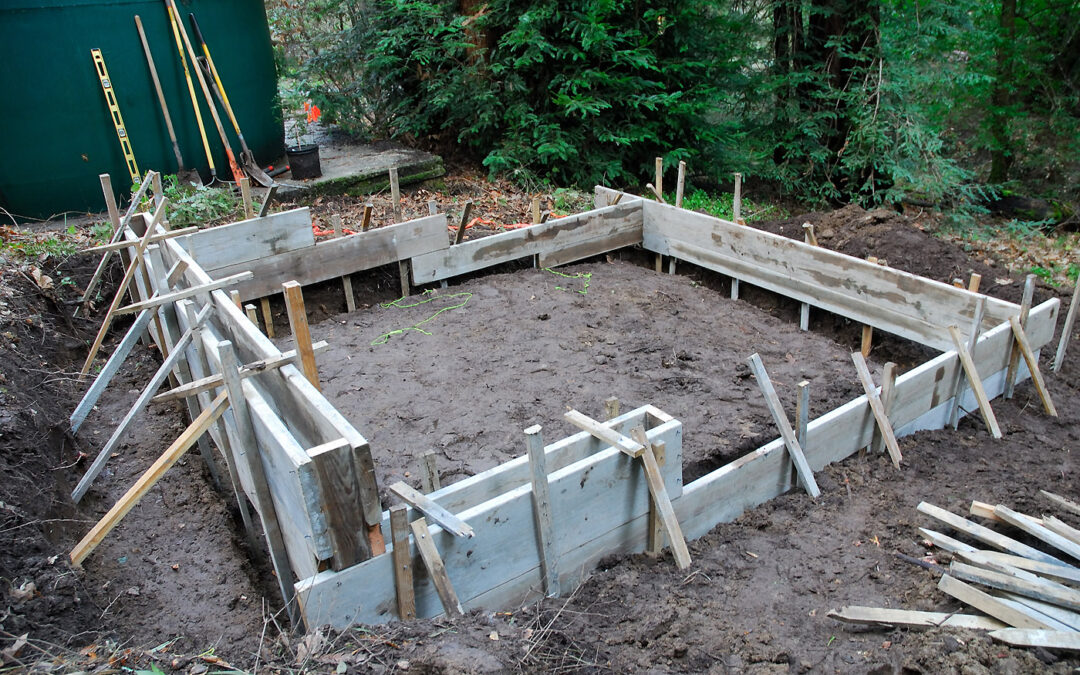
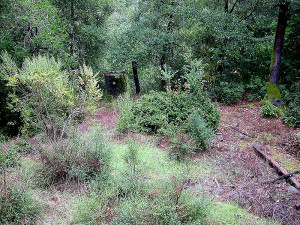
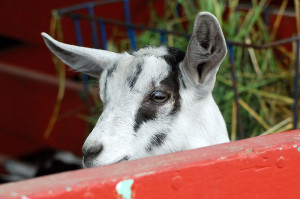


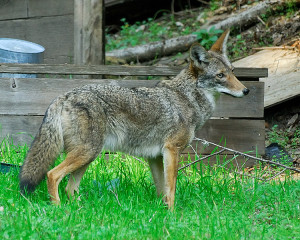


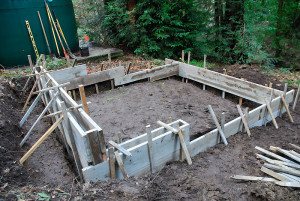
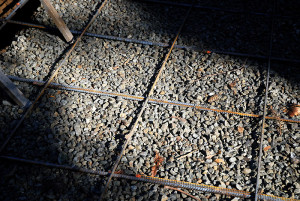
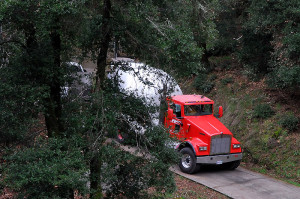

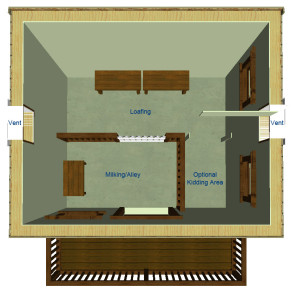








Go CVF! Looks great so far! Can’t wait to see the final barn and of course the new kids!
Thanks Rachel! I’m excited to see the barn done too, and even more excited to see the kids. So far we’ve met the parents, but meeting the kids the first time will be extra special! I can’t wait 😉
You are so going to love this, I know. I’m thrilled for you! I would just love to sit on the covered deck in the rain, that would be my little bit of heaven. Your goats will be happy little campers. Will you be able to find homes for the babies? I know you’ll post more about milk goats etc in the future, but I’m curious now. One of the reasons I won’t go in for milk goats is that I don’t want to raise meat animals.
I don’t think it will be too challenging finding homes for the kids. We will be showing these goats, and breeding for dairy character, and quality. I’m hoping that by investing in a strong foundation for our herd, and breeding for quality goats, that they’ll find good homes. If we end up with all wethers, as I can’t control if the does have boys or girls, we do have a friend who keeps a goat herd as part of his brush clearing business 😉
I can’t wait! I was already living vicariously through you with your chickens, turkeys, and bees. Goats are even more exciting.
See, that’s what got us in trouble. Chickens. They’re the gateway barnyard animal…and then it’s a slippery slope. We should probably stop with goats though, before we end up with elephants 😛
I have two Nigerian dwarf goats whom I have befriended over the last two summers on the island that I visit in Maine (I think I mentioned this). Their names are Trillium and Lilac and they have the cutest personalities. I take them for walks. They are very funny because to get them to come all you have to do is disappear around a corner. They think they have lost their herd and will come running. They love to leap around on the cliffs for which the island is named. I am very jealous of your new goats.
Awww, I love the name Trillium for a goat, but it’s also my favorite wildflower here. We’ll be taking our goats for lots of walks here. We definitely have a property that should be very intriguing to goats. I can just envision Trillium and Lilac playing hide-and-seek with you, and can’t wait to play a game or two of that with ours too! 🙂
I’m really excited to see the goats. I’ve always told my husband that if we ever live where we have enough space I really want pygmy goats, I love them. This is going to be so fun to watch the barn being built and seeing how the goats do.
It will be fun to see it all come together. I can’t wait to actually see goats in the ‘barn’. The trouble is, I may never want to leave. I remember not getting anything productive done after Jenny’s chicks hatched last year, I can’t imagine what I’ll be like when the kids arrive 😛
Clare,
So well thought out, the barn. Look like a professional job for sure. Hope these goats don’t get stuck in the fences. I doubt they will. Cheese, yes!!!
Haha, no, I’d hate to drive my neighbors crazy with the sound of goats stuck in the fences. The goats won’t have horns, which will certainly help. Most goats I’ve seen with their heads stuck have horns, and get caught when they try to pull back. Our fence for the enclosure is most likely to be chain link, so the holes will be quite small. The enclosure needs to be covered, and chain link is actually strong enough should an enterprising mountain lion jump up there and try to stand on it. I agree, CHEESE…I can’t wait, I just hope I have time to get the spring garden planted before the doelings arrive! 😯
Quite interesting and quite and undertaking. Can’t wait to see the baby goats. Our neighbor has little pigmy goats to eat the weeds. We enjoy watching them. Because we have restrictions here, we are limited to number of animals we can have, but goats are on the long list. My husband also wants a couple of Suffolk sheep. Goats or sheep. Nothing as ambitious as milking–he grew up on a dairy. Pets. We already have a barn. Still, I will enjoy keeping up with your goat project. Good luck.
I’m envious you already have a barn! Dairy goats certainly do require an extra level of commitment, both for their care, and of course, milking. I think it will be fun though, especially in a nice dry barn 😉
I am so excited that you are getting goats! What a great barn you’ve built for them. I’m looking forward to seeing videos on your blog about them. I bet they will be just adorable. And yummy goat cheese? Cool!
Do you follow the blog Mack Hill Farm? They have five animal guard dogs — two Icelandic shepherds and three Great Pyrs. Wonderful dogs, they are hard workers. Here’s a link in case you’ve never heard of it.
http://www.mackhillfarm.com/
I wish the barn was finished, but hopefully soon 😛
I looked into Great Pyrenees, and they are beautiful dogs, but also rather hairy. We have a LOT of redwood leaf litter, and I’d be half afraid they’d be caked in it constantly. Not to mention, we have a horrendous number of ticks here in the spring time, and digging for ticks under all that fur could be a tremendous challenge. That said, short-coated LGD breeds aren’t quite as common. Some Akbash, and Anatolians have shorter coats. We’re still doing our homework on the LGD front though 🙂
Goats! Oh goody, looking forward to reading your goat stories very much!
Not as much as I’m looking forward to writing them…if you can drag me out of the barn that is. We’re not putting DSL in the barn 😛
Wow, that will be quite an adventure! Maybe you need a lama to protect the goars? I’ve heard they’re quite good at chasing off predators.
Llamas can be very effective guardians, especially toward coyotes, but not as much for Mountain Lions. The biggest issue here for a Llama though, is it would require a barn, and an enclosure, that is an order of magnitude larger than we’re planning to build. For this property, I just don’t think they’re practical, although they would love all the hills here 😉
Wow – you don’t mess around. When you want something you give it 110% – I am so amazed at the construction! Well done! PLEASE keep me up to date. We had a pigmy mountain goat before – cute but demanding as a pet!
I can be slow to get projects under way here, but that’s because I have a tendency to overdo the homework first. I like to do things right the first time, in an efficient manner, but that’s only because I’m a little impatient by nature 😉 I’m definitely planning to ‘share’ the goats on the blog. I just have to remember NOT to neglect the garden this spring!
You are being wise by planning well before you get your Goats. Looking fotward to seeing them.
I’m hoping all the ground work before the goats arrive will pay off. I feel like time is zipping by, they’ll be on the ground before we know it!
You can’t hear me, but I’m squealing with glee. Goats! I’m excited for you, and eager to read the developments. You do such a good job documenting projects, and I often try to make a mental note to return when I am living on my own land and use the resource you’ve built for guidance… Have fun with construction.
I thought I heard something this morning 😛 I think I tend to write everything down, just in case I have to do it again. Then I can know exactly what I did, what worked, and what didn’t. I think it’s because I have a tendency to be a little forgetful 😛
Oh how cute! It seems like you’ve done good research and put a lot of work into this. I only wish I lived on the Pacific COast so I could have access to the yummy cheese.
One of the reasons I enjoy your blog so much is because of your animals, as well as your garden. I actually wanted to pass along a Versatile Blogger Award to you. Your blog defeinitely fits the definition. I’ll be posting about it officially tomorrow. I hope you accept. 🙂 I’m looking forward to following you on this new venture!
I really can’t wait to experiment with my own cheese. Of all the cheese we eat, I think we eat goat cheese the most now, so I’m sure we’ll be eating much more of it soon! I’d like to try some of the other drier, aged goat cheeses too.
Thanks for the award nod, sometimes I feel a little spazzy about what I’m blogging about, but that’s mostly how things are here…having our attention divided between construction projects, our animals, the wildlife, and the gardens. So glad you enjoy it!
Clare, I always admire the thoughtfulness and care you put into planning all of the aspects of your farm. Adding goats seems to be such a perfect idea. I like the photo of the bobcat by the wheel of the vehicle…as if he is a housecat…cute!
Ah yes, we’ve dubbed that particular bobcat ‘bruiser bob’. He’s a very healthy, well-fleshed feline, who seems to be particularly enamored with our rooster, Frodo. Bob has no qualms about making it clear whose land this really is 😉 We do love seeing him though, and that day, resting in front of Mr. CV’s car, he really looked like he owned the place!
How exciting! And it looks like you have everything planned out so well. You are always coming up with BIG projects! I admire your energy! Didn’t realize goats needed milking two times a day. Will you ever get to take a vacation? I hope your new goats are perfect, and that the milk and cheese (yum!) taste wonderful!
Well, we’ll see how the plans work out…hopefully we won’t have too many odd surprises during barn construction. You can just milk once a day, but overall yields are better with twice a day milking, and some goats are probably more comfortable being milked every 12 hours too.
Vacation? What’s that? 😛 Honestly, we haven’t taken a vacation in eight years. I don’t think once the goats arrive we’ll be able to for quite some time, but that’s ok. I like being here!
Clare I am so impressed…bees last year with the turkeys and chickens and now goats…how cool this is going to be seeing the barn and then the goats and all the fun you will be having….congrats and I look forward to learning more about the goats.
We definitely won’t be breeding turkeys this year, just too much going on! Except for spring splits, I’m hoping the bees will be a little more self-sufficient this year, as the hive structure is built, although we will have to occasionally keep our eye on honey stores. I have a feeling the goats will get more attention than the gardens this year, but I’ll have to make a conscious effort to strive for balance. We’ll see how that works out…
oh my goodness that’s a lot of planning but you’ve done it exceptionally well. Those drawings are fantastic and it looks like you’ve thought of everything. I had no idea goats were so adverse to rain. Looking forward to learning more about them in the coming months.
I know, you wouldn’t think goats would be such wimps in the rain would you? Here, my biggest concern in wet weather is hoof health, as they’re prone to a number of problems when their hooves get wet for extended periods. That’s part of why we’re building the deck in front. At least they can be outside, but if it’s too soggy in the yard they’ll have somewhere high and dry. In some respects though, that’s the good thing about having their enclosure on a slope…it will drain!
My, your farm family is growing. I too admire your thorough approach and thoughtfulness in planning for their safety and soon arrival. Always an adventure at Curbstone Valley Farm. Much luck passed on to you in your new experience.
Thanks Donna, you’re right, there’s never a dull moment here 😉
Great work. You certainly have a big job ahead of you. I can tell you are having a of fun. A friend has a sheep herd on the top of a hill were there can not watch them. They have a lot of predator issues as well. They use guard donkeys. Have a great day.
I wish we had room for a donkey, I’m rather fond of them. I don’t think our ‘barn’ would be big enough though 😉 You’re right though, it is turning out to be quite a big project!
How exciting! I agree that goats are adorable, and we have sometimes entertained the idea of owning goats, to keep the weeds down. But it’s only a fantasy, and I am thrilled to see you are actually doing it. I suspect your goat barn will be a goat’s dream mansion and be very attractive to humans, as well.
A couple of people have commented “wow, your goat barn will have four walls, AND a door?” 😛 They may seem spoiled to some, but we’re convinced that anything less rugged and durable would be too easy for predators to defeat. I am happy with how it’s turning out though, and I know I’ll be nice and dry in there when milking the goats in winter! It’s hard work now, but it will all be worth it.
This surely is a new phase of your farm life and looks like you’re doing a splendid job of it. I know that coyotes are a real threat to your livestock, but that photo, Clare shows just how beautiful they can be.
Don’t forget to plan a playground for your goats. They like to be up on top of things, funnily enough. I have even seen my neighbor goats with a plank set between to oil cans and they walk across the ‘balance beam.’ It will enjoyable to see how your goat shed progresses. Sue
We do have some playground structures planned. We have no shortage of tree stumps around here that we can use to build a fun climbing area, and a local rockery has some fabulous huge rocks that we’re looking at too. I’m looking forward to seeing all this done, and watching the goats having lots of fun outside!
What a great Christmas present! I can’t wait to see and hear about the new additions when they arrive. And I can almost taste the chèvre!
Sadly, cheese will be over a year away, but that’s ok, we have enough going on at the moment just getting everything set up for the goat’s arrival. I’m looking forward to spending a little down-time with them once they get here!
looking good! wow, goats… they are a lot of work!
They are a LOT of work…and they’re not even here yet! 😛
I had a goat growing up.. Oatie Goatie. (I was so insanely clever as a kid). Oatie was adopted by us because he was the runt of a neighbors litter(?) and was getting smacked around on a regular basis as a little baby by the rest of the goat gang. So we took him to our house, and he grew up with all of our dogs. And lived in our basement for that first winter because it was unusually cold for his super tiny self. So, basically, he thought he was a dog, except he randomly would eat things like roses and bushes to my mom’s consternation. He never did get normal sized so he just remained a goat/dog his whole life so far as all us kids were concerned. 🙂 Toward the end of his life he took a shine to the horses and decided he’d rather be a horse than a dog (also the head dog had passed away). I suspect he had identity issues.
Cute! I met a little undersized Nigerian Dwarf wether last spring that was exquisitely leash trained, and phenomenally friendly. He too had some setbacks as a youngster, but he turned out fine, and was much friendlier than most dogs. He clearly thought he was human! 😉
Wow, how exciting! One of my neighbors used to have a pygmy goat named Charlie that would occasionally make his way onto our property. He had a bright red collar with his name and phone number on it, so he was obviously an accomplished escape artist. Charlie was also one of those goats that hung out with all of their pet dogs and was, essentially, more dog than goat. What I loved most about Charlie, other than his charming cuteness, was the fact that he’d start grazing on our weeds the moment he crossed over to our side – how awesome is that? Anyways, we would love to have goats ourselves, but not until I’ve retired from my office day job. In the meantime, will live vicariously through your future goat posts!
That’s great that Charlie worked on the weeds, rather than your garden plants! I’m wondering how much time I’ll have around here for non-goat projects once they arrive. At the moment I’m struggling to stay on schedule with seed-sowing as the barn/shed is taking up every daylight free hour we have!
Clare, you really do your homework. I love how I just have to check in with what you’re doing for a master class on everything from Goat barns to chicken raising. You’re amazing!
Awww, thanks Tom! Yesterday a neighbor’s friend stopped by and seemed very impressed with our progress, and suggested we should teach the master framing class at the local college. I laughed out loud, and told him I might not want to see ANY framing for quite some time once this project is complete! We’ve both rediscovered muscles we’d forgotten existed, and Ibuprofen consumption around here has increased significantly in the past week! 😛
I second what Tom has just posted. The CV farmers are not Jack/Jills of all trades but masters of many. Who drew up the plans? I already know more about goats than I will ever use and now await the oohs & aahs of kids arrival.
The plan-drawing was my department. The software I used was originally meant for drafting plans for our future kitchen remodel, as we can print them to the right scale for permit applications. As the kitchen is clearly on hold for the time being, I thought I’d use it to draw out the goat shed. The most challenging part was figuring out where to place gates (or not), thinking about how the shed will be used on a day to day basis. Once we had the layout figured out though, drawing the plans up was easy.
Oh Clare this is great news and I’m so excited for you. My friend is thinking of getting some goats primarily for their milk and cheese and she has just added some ducks to her small holding.
I miss having a duck around. We had an orphan duck we raised at our last house, and they’re quite comical creatures, with a taste for slugs and snails! 🙂
I love that you’re constantly doing projects like this — always building something (or so it seems). Building stuff, even necessary stuff, is *fun*.
It does seem like we’re always building something, from poultry housing, to retaining walls, greenhouses, and now sheds. I’m hoping the building projects will slow down though, so we can actually start enjoying what we’ve done so far! It is fun though…albeit exhausting 😉
How exciting! I look forward to lots of “cute kid” posts as spring arrives. I’m always impressed by your careful planning and design work.
I expect there’ll be no shortage of goatie cuteness showing up on the blog once they arrive. I might have to do the occasional poultry post though, just so the chickens don’t feel left out 😉